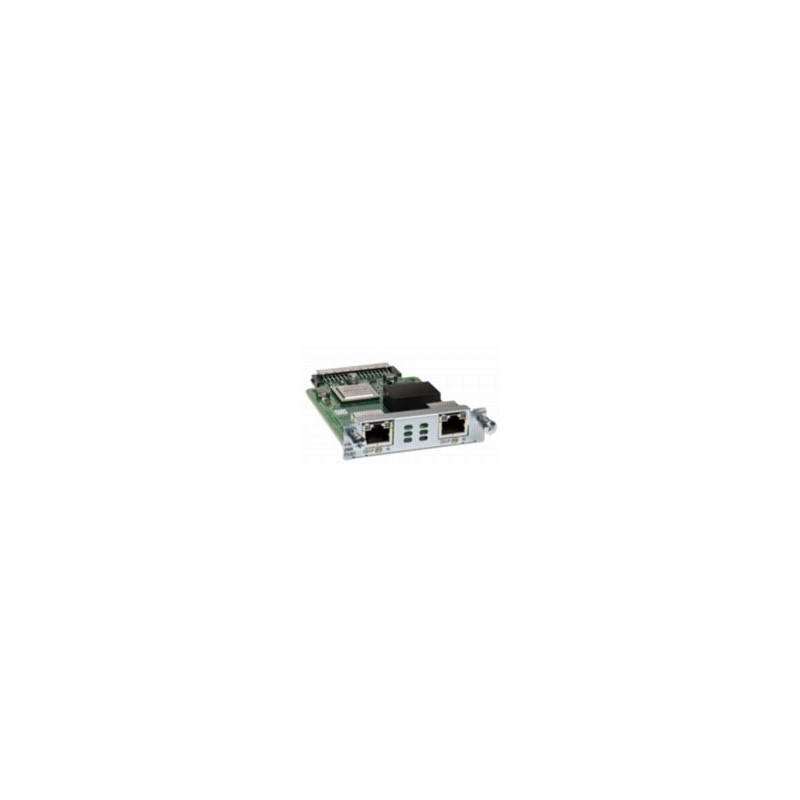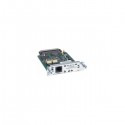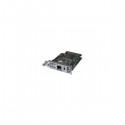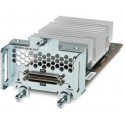
Introduction
The Cisco® Third-generation 1-, 2-port and 4-port T1/E1 Multiflex Trunk Voice/WAN Interface (MFT VWIC3s) support data and voice applications on the Cisco 1921, 1941 and 1941W (data only), and the Cisco 2901, 2911, 2921, 2951, 3925, 3945, 3925E and 3945E Integrated Services Routers. The Cisco MFT VWIC3 combines WAN-interface-card (WIC) and voice-interface-card (VIC) functions to provide unparalleled flexibility, versatility, and investment protection through its many uses. Customers who choose to integrate data and voice in multiple steps preserve their investment in a T1/E1 WAN interface because the Cisco MFT VWIC3 cards can be reused in packet voice applications. The 2 port T1/E1 MFT VWIC3 is shown below.
The Cisco MFT VWIC3 interface cards add improvements over the Cisco Second-generation 1- and 2-port T1/E1 Multiflex Voice/WAN Interface Cards (MFT VWIC2s). The Cisco 2- and 4-port MFT VWIC3s enable each port to be clocked from an independent clock source for data applications. Voice applications can now be clocked independently from data applications, with all ports for voice applications clocked from a single source. The Cisco MFT VWIC3s use the ECAN on the motherboard PVDM cards with up to 128ms echo-tail length for demanding network conditions. MFT VWIC3 cards support up to 2 channel groups per T1/E1 port for serial data applications. Refer to Table 3 for all configuration options offered with the MFT VWIC3 cards.
The Cisco MFT VWIC3 cards can be inserted into the EHWIC slot on the supported Cisco 1921, 1941, 1941W, 2901, 2911, 2921, 2951, 3925, 3945, 3925E and 3945E integrated services routers. The T1/E1 MFT VWIC3 cards support both T1 and E1, providing additional flexibility in configuring the Cisco MFT VWIC3s for supporting T1, fractional T1, E1, and fractional E1 for both voice and WAN applications. All MFT VWIC3 modules include the drop-and-insert multiplexing capability, which eliminates costly external third-party channel service units/data service units (CSUs/DSUs) and drop-and-insert multiplexers.
The Cisco® Third-generation 1-, 2-port and 4-port T1/E1 Multiflex Trunk Voice/WAN Interface (MFT VWIC3s) support data and voice applications on the Cisco 1921, 1941 and 1941W (data only), and the Cisco 2901, 2911, 2921, 2951, 3925, 3945, 3925E and 3945E Integrated Services Routers. The Cisco MFT VWIC3 combines WAN-interface-card (WIC) and voice-interface-card (VIC) functions to provide unparalleled flexibility, versatility, and investment protection through its many uses. Customers who choose to integrate data and voice in multiple steps preserve their investment in a T1/E1 WAN interface because the Cisco MFT VWIC3 cards can be reused in packet voice applications. The 2 port T1/E1 MFT VWIC3 is shown below.
The Cisco MFT VWIC3 interface cards add improvements over the Cisco Second-generation 1- and 2-port T1/E1 Multiflex Voice/WAN Interface Cards (MFT VWIC2s). The Cisco 2- and 4-port MFT VWIC3s enable each port to be clocked from an independent clock source for data applications. Voice applications can now be clocked independently from data applications, with all ports for voice applications clocked from a single source. The Cisco MFT VWIC3s use the ECAN on the motherboard PVDM cards with up to 128ms echo-tail length for demanding network conditions. MFT VWIC3 cards support up to 2 channel groups per T1/E1 port for serial data applications. Refer to Table 3 for all configuration options offered with the MFT VWIC3 cards.
The Cisco MFT VWIC3 cards can be inserted into the EHWIC slot on the supported Cisco 1921, 1941, 1941W, 2901, 2911, 2921, 2951, 3925, 3945, 3925E and 3945E integrated services routers. The T1/E1 MFT VWIC3 cards support both T1 and E1, providing additional flexibility in configuring the Cisco MFT VWIC3s for supporting T1, fractional T1, E1, and fractional E1 for both voice and WAN applications. All MFT VWIC3 modules include the drop-and-insert multiplexing capability, which eliminates costly external third-party channel service units/data service units (CSUs/DSUs) and drop-and-insert multiplexers.
| Cables included | LAN (RJ-45) |
| Connectivity technology | Wired |
| Depth | 120.4 mm |
| Ethernet LAN (RJ-45) ports quantity | 2 |
| Host interface | CardBus |
| Source data-sheet | Icecat.biz |
| Transfer rate | 2.048 MB/s |
| Weight | 86 g |
| Width | 78.2 mm |
Cisco VWIC3-2MFT-G703
VWIC3-2MFT-G703 - 1.544 Mbps ± 50 bps/32 ppm/2.048 Mbps ± 100 bps/50 ppm, T1, E1, VIC, 2x G.703, Spare
VWIC3-2MFT-G703=
Out of Stock
£3,218.54
£2,682.12 Ex VAT. 


